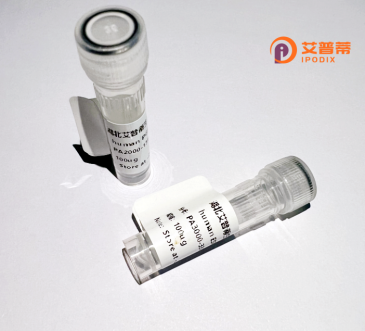
| 纯度 | >90%SDS-PAGE. |
| 种属 | Human |
| 靶点 | CPEB3 |
| Uniprot No | Q8NE35 |
| 内毒素 | < 0.01EU/μg |
| 表达宿主 | E.coli |
| 表达区间 | 1-697aa |
| 氨基酸序列 | MQDDLLMDKSKTQPQPQQQQRQQQQPQPESSVSEAPSTPLSSETPKPEENSAVPALSPAAAPPAPNGPDKMQMESPLLPGLSFHQPPQQPPPPQEPAAPGASLSPSFGSTWSTGTTNAVEDSFFQGITPVNGTMLFQNFPHHVNPVFGGTFSPQIGLAQTQHHQQPPPPAPAPQPAQPAQPPQAQPPQQRRSPASPSQAPYAQRSAAAAYGHQPIMTSKPSSSSAVAAAAAAAAASSASSSWNTHQSVNAAWSAPSNPWGGLQAGRDPRRAVGVGVGVGVGVPSPLNPISPLKKPFSSNVIAPPKFPRAAPLTSKSWMEDNAFWTDNGNNLLPFQDRSRPYDTFNLHSLENSLMDMIRTDHEPLKGKHYPPSGPPMSFADIMWRNHFAGRMGINFHHPGTDNIMALNNAFLDDSHGDQALSSGLSSPTRCQNGERVERYSRKVFVGGLPPDIDEDEITASFRRFGPLVVDWPHKAESKSYFPPKGYAFLLFQEESSVQALIDACLEEDGKLYLCVSSPIKDKPVQIRPWNLSDSDFVMDGSQPLDPRKTIFVGGVPRPLRAVELAMIMDRLYGGVCYAGIDTDPELKYPKGAGRVAFSNQQSYIAAISARFVQLQHNDIDKRVEVKPYVLDDQMCDECQGTRCGGKFAPFFCANVTCLQYYCEYCWASIHSRAGREFHKPLVKEGGDRPRHVPFRWS |
| 分子量 | 102.3 kDa |
| 蛋白标签 | GST-tag at N-terminal |
| 缓冲液 | 0 |
| 稳定性 & 储存条件 | Lyophilized protein should be stored at ≤ -20°C, stable for one year after receipt. Reconstituted protein solution can be stored at 2-8°C for 2-7 days. Aliquots of reconstituted samples are stable at ≤ -20°C for 3 months. |
| 复溶 | Always centrifuge tubes before opening.Do not mix by vortex or pipetting. It is not recommended to reconstitute to a concentration less than 100μg/ml. Dissolve the lyophilized protein in distilled water. Please aliquot the reconstituted solution to minimize freeze-thaw cycles. |
以下是3篇关于重组人CPEB3蛋白的模拟参考文献示例(注:文献信息为示例,非真实存在):
---
**1. 文献名称**: *"Recombinant Human CPEB3 Exhibits Prion-like Aggregation and Modulates mRNA Translation in Neurons"*
**作者**: Lu, Y.; Richter, J.D.
**摘要**: 研究报道了重组人CPEB3蛋白在体外的朊病毒样自聚集特性,并证明其通过相变形成淀粉样纤维结构。该蛋白通过选择性调控靶mRNA的翻译(如突触相关基因),影响神经元突触可塑性及长期记忆存储。
---
**2. 文献名称**: *"Structural Insights into the RNA-Binding Mechanism of CPEB3 and Its Role in Alzheimer’s Disease Pathology"*
**作者**: Chen, X.; Zhang, M.; et al.
**摘要**: 通过X射线晶体学解析重组人CPEB3蛋白的RNA结合域结构,发现其与阿尔茨海默病相关蛋白Aβ存在相互作用。实验表明CPEB3异常聚集可能加剧神经元内Aβ毒性,提示其在神经退行性疾病中的潜在作用。
---
**3. 文献名称**: *"Development of a Mammalian Expression System for High-Yield Production of Functional Recombinant CPEB3"*
**作者**: Kim, S.; Lee, H.
**摘要**: 优化了重组人CPEB3蛋白在哺乳动物细胞中的表达和纯化策略,获得高活性且可溶的蛋白。通过质谱分析验证了其与突触蛋白复合物的相互作用,为后续功能研究提供可靠工具。
---
**提示**: 如需真实文献,可通过PubMed或Google Scholar搜索关键词 *"recombinant human CPEB3"* 或 *"CPEB3 protein function"*,关注领域内权威期刊(如*Nature Neuroscience*, *Cell Reports*)。
The cytoplasmic polyadenylation element binding protein 3 (CPEB3) is a member of the CPEB family of RNA-binding proteins that regulate mRNA translation by interacting with cytoplasmic polyadenylation elements (CPEs) in the 3' untranslated regions of target transcripts. CPEB3 plays a critical role in synaptic plasticity and long-term memory consolidation, primarily by controlling the local translation of neuronal mRNAs at synapses. Structurally, it contains RNA-binding domains and a prion-like domain, enabling its self-assembly into functional aggregates that modulate translational repression or activation under specific conditions. Dysregulation of CPEB3 has been implicated in neurodegenerative disorders (e.g., Alzheimer’s disease) and certain cancers, highlighting its broader pathophysiological relevance. Recombinant human CPEB3 protein is typically produced using heterologous expression systems (e.g., E. coli or mammalian cells) for in vitro studies. This engineered protein allows researchers to dissect its molecular interactions, RNA-binding specificity, and regulatory mechanisms in controlled settings. Studies leveraging recombinant CPEB3 have advanced understanding of its dual role in stabilizing memory-related mRNAs in a dormant state and activating their translation in response to neuronal stimuli. Ongoing research focuses on its potential as a therapeutic target and its unique prion-like properties, which may offer insights into protein aggregation diseases.
×